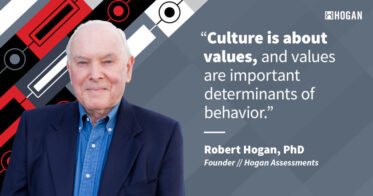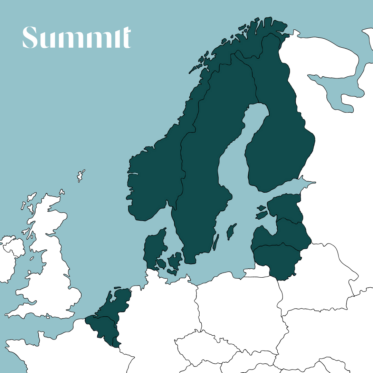One leadership skillset concerns advancing into positions of authority and getting to the top of organizations. At Hogan, we call this emergent leadership. A separate skillset concerns leading those organizations to success. We call this effective leadership.
Recently on The Science of Personality, cohosts Ryne Sherman, PhD, chief science officer, and Blake Loepp, PR manager, discussed the core issue of the difference between leadership emergence and leadership effectiveness.
“Leaders who know when to go with their strengths but also know when their strengths lead them in the wrong direction—those are the leaders who are the most effective,” said Ryne.
Let’s dive into this conversation about what makes an effective leader.
What’s the Difference Between Leadership Emergence and Leadership Effectiveness?
Finding numerous studies of leadership in academic literature isn’t hard. Leadership as a topic is in high demand—any bookstore is filled with leadership books. Both academic and popular writing on leadership, however, fail to distinguish between these two key topics of emergence and effectiveness. They hold the common assumption that if you are a leader in an organization, you must, by definition, be effective. But reality proves that many organizations are led ineffectively. Having a leadership role and being a good leader just aren’t the same.
- Leadership emergence – In Hogan terms, emergent leaders get into leadership positions. They belong to the C-suite, or they hold board positions. They climb the corporate ladder, so to speak.
- Leadership effectiveness – Effective leaders build high-performing teams. They can create and maintain a team that produces results. An effective leader is judged by the success of the team’s accomplishments.
Studying leadership emergence isn’t too difficult. If you survey the CEOs of Fortune 500 companies, you’ll find that most leaders are men named John who have strong political skills. Studying leadership effectiveness is much more difficult. Team results are hard to quantify because more than just the leader is involved in what makes a team successful in an organizational context.
Compared to the average leadership memoir or academic study, what we think about leadership at Hogan sounds quite different. “It’s about leading organizations to success,” said Ryne.
Personality and Leadership
Personality data are quite predictive of who becomes an emergent leader but are much less definite about who becomes an effective leader.
Personality and the Emergent Leader
In terms of the Big Five or the five-factor model, there is strong metanalytic evidence for who tends to become an emergent leader or who gains status in an organization. Broadly, this person has high emotional stability, high extraversion, high openness to experience, and high conscientiousness. Agreeableness was unrelated to getting into leadership positions.
“When you combine the Big Five personality traits, we see a strong prediction of who’s going to become a leader. Personality predicts leadership emergence really well,” Ryne said.
Personality and the Effective Leader
Leadership effectiveness is, as we said, difficult to measure. Objective data, such as stock market value, are influenced by many factors other than organizational leadership. Intangible characteristics, such as integrity, business competence, good judgment, and vision, are related to personality but aren’t quite the same thing.
What constitutes good criteria for determining leadership effectiveness?
Hogan and Kaiser Leadership Solutions, one of our solutions partners, studied thousands of top leaders in the US and Europe using 360-degree feedback data. The leaders were rated on a single item of overall effectiveness by their subordinates, peers, and supervisors (if they had any). “It’s just simply from one to 10, how effective is this person as a leader?” Ryne explained. “If people who know you and work with you on a daily basis say you’re effective, then that probably means you’re effective.”
Ryne said he was stunned by the unexpected results. The data showed that personality is only weakly related to leadership effectiveness . . . but that’s only half the interpretation.
Personality data predicts behavior extremely well. It predicts if you’re likely to be too forceful, too demanding, too enabling, too strategic, too operational—it predicts leadership ineffectiveness. “Personality is much better at predicting the ways leaders go wrong than the ways they go right,” Ryne said.
Leadership effectiveness isn’t necessarily about having specific personality characteristics but about balancing those different behaviors. In other words, it’s about versatility. Ryne continued: “Effective leaders are versatile leaders. To be a versatile leader, you have to adapt your behavior. You can’t just stick to one strategy all the time.”
There is no one, single personality profile for leadership effectiveness because leaders who cannot or do not adapt their behavior aren’t effective. Versatility is the key, not the ability to focus on operational details or to push for results. Knowing how to adapt to the situation, including when to act against your natural tendencies, is what makes leaders effective. At Hogan, we call this strategic self-awareness.
How to Find Effective Leaders
Effective leaders understand their strengths, weaknesses, and behavioral tendencies. These leaders have the strategic self-awareness first to know when their usual mode of behavior is less advantageous and then to self-correct. Based on past experiences that challenged their natural inclinations, they can leverage adaptive behavioral skills to be tactical when they need to be tactical and strategic when they need to be strategic.
If someone is a strong operational leader, for example, they have likely gained a role where their organizational skills, compliance, process focus, and conscientiousness about details and rules have paid off for them and their teams. In some circumstances, though, it would benefit them, their team, and their organization if they emphasized strategy and adopted a long-term focus. An effective leader knows when that shift is required and brings contextual balance by adapting their behavior and relying on the strengths of others.
How should organizations go about choosing their leaders, then?
Be wary of charisma, which is predictive of leadership emergence. The most obvious candidate for a leadership position may be able to bring strategic vision but fall short on effective leadership. Don’t place too much emphasis on emergent characteristics like political aptitude.
Use assessments to determine alignment between a person’s strengths and weaknesses as a leader and the current organizational needs. Consider the right characteristics and skills to help you solve problems in the short term and grow in the long term. Finally, consider which people can adapt and flex when the situation calls for it.
Look for future leaders from within. High-potential leaders are people who understand the business well, have a history of good judgment, and are trusted by their teams and peers. They are people others are willing to follow. “I wouldn’t be looking for a particular personality profile,” Ryne said. “I would be saying, ‘Given your individual personality profile, how can I develop you personally to be more effective as we move you into a leadership role?’”
Listen to this conversation in full on episode 70 of The Science of Personality.
This post was originally published on the Hogan Assessments blog.



